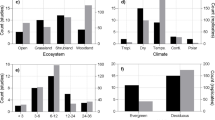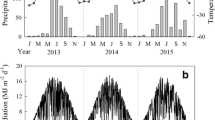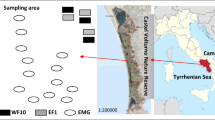Abstract
Photodegradation can play a key role in litter decomposition under the context of climate change which hinders organic matter turnover because of available water scarcity. Here, we aimed at testing the effect of a two-month sunlight exposure with different radiation intensities (either in winter or summer) on the chemical signature of two typical Mediterranean species, i.e., Quercus ilex and Q. pubescens. We also tested whether the side of the leaf exposed mattered in the chemical modification observed. To do so, two holistic chemical approaches, FTIR-ATR (Fourier transform infrared–attenuated total reflectance) and solid-state NMR of 13C, were used. ANOVA from solid-state NMR of 13C revealed that after exposure in summer, certain markers of lignin (phenol and aromatics) decreased in leaves whatever the Quercus spp. and it depended on the side of the leaf exposed. Lignin transformation thus occurred via dearomatization and/or dephenolization. Moreover, for both species, when leaves were exposed at their topside, their NMR chemical signatures were negatively correlated with alkyl assigned to cutin and waxes, showing that the thin layer of cuticle was attacked by photodegradation. FTIR-ATR spectra and NMR data also highlighted that a weaker irradiation (winter vs summer exposure) strongly limited lignin content decrease. Finally, lignin, cutin and wax oxidation, by enhancing the availability of polysaccharides from lignocellulose, may favor further litter transformation when suitable climate conditions (mainly humidity) are recovered.







Similar content being viewed by others
References
Almagro M, Maestre FT, Martinez-Lopez J, Valencia E, Rey A (2015) Climate change may reduce litter decomposition while enhancing the contribution of photodegradation in dry perennial Mediterranean grassland. Soil Biol Biochem 90:214–223. https://doi.org/10.1016/j.soilbio.2015.08.006
Austin AT, Vivanco L (2006) Plant litter decomposition in a semi-arid ecosystem controlled by photodegradation. Nature 442:555–558. https://doi.org/10.1038/nature05038
Austin AT, Méndez MS, Ballaré CL (2016) Photodegradation alleviates the lignin bottleneck for carbon turnover in terrestrial ecosystems. Proceed Natl Acad Sci USA 113:4392–4397. https://doi.org/10.1073/pnas.1516157113
Baldock JA, Oades JM, Preston CM, Nelson PN, Skene TM, Golchin A, Clark P (1997) Assessing the extent of decomposition of natural organic materials using solid state 13C NMR spectroscopy. Aust J Soil Res 35:1061–1083. https://doi.org/10.1071/S97004
Baldrian P (2006) Fungal laccases-occurrence and properties. FEMS Microbiol Rev 30:215–242. https://doi.org/10.1111/j.1574-4976.2005.00010.x
Bornman JF, Barnes PW, Robinson SA, Ballaré CL, Flint SD (2014) Solar ultraviolet radiation and ozone depletion-driven climate change: effects on terrestrial ecosystems. Photochem Photobiol Sci 14:88–107. https://doi.org/10.1039/c4pp90034k
Boukhdoud N, Gros R, Darwish T, Farnet Da Silva AM (2016) Effect of agricultural practices and coastal constraints on soil microbial functional properties in Mediterranean olive orchards. Europ J Soil Sci 67:470–477. https://doi.org/10.1111/ejss.12347
Brandt LA, King JY, Milchunas DG (2007) Effects of ultraviolet radiation on litter decomposition depend on precipitation and litter chemistry in a shortgrass steppe ecosystem. Global Change Biol 13:2193–2205
Brunel C, Gros R, Ziarelli F, Farnet Da Silva AM (2017) Additive or non-additive effect of mixing oak in pine stands on soil properties depends on the tree species in Mediterranean forests. Sci Total Environ 590:676–685
CalSol software. Institut National de l’ Energie solaire (INES). ines.solaire.free.fr/dataclim_1.php. Accessed May 2021.
Coûteaux MM, Bottner P, Berg B (1995) Litter decomposition, climate and litter quality. Trend in Ecology & Evolution 10:63–66. https://doi.org/10.1016/S0169-5347(00)88978-8
Day TA, Zhang ET, Ruhland CT (2007) Exposure to solar UV-B radiation accelerates mass and lignin loss of Larrea tridentate litter in the Sonoran desert. Plant Ecol 193:185–194. https://doi.org/10.1007/s11258-006-9257-6
Day TA, Guénon R, Ruhland CT (2015) Photodegradation of plant litter in the Sonoran desert varies by litter type and age. Soil Biol Biochem 89:109–122. https://doi.org/10.1016/j.soilbio.2015.06.029
Day TA, Bliss MS, Tomes AR, Ruhland CT, Guénon R (2018) Desert leaf litter decay: coupling of microbial respiration, water-soluble fractions and photodegradation. Glob Change Biol 24:5454–5470. https://doi.org/10.1111/gcb.14438
Delcourt N, Rébufa C, Dupuy N, Boukhdoud N, Brunel C, Abadie J, Giffard I, Farnet-Da Silva AM (2019) Infrared spectroscopy as a useful tool to predict land use depending on Mediterranean contrasted climate conditions: a case study on soils from olive orchards and forests. Sci Total Environ 686:179–190. https://doi.org/10.1016/j.scitotenv.2019.05.240
Duguay KJ, Klironomos JN (2000) Direct and indirect effects of enhanced UV-B radiation on the decomposing and competitive abilities of saprobic fungi. Appl Soil Ecol 14:157–164. https://doi.org/10.1016/S0929-1393(00)00049-4
Esch EH, King JY, Cleland EE (2019) Foliar litter chemistry mediates susceptibility to UV degradation in two dominant species from a semi-arid ecosystem. Plant Soil 440:265–276. https://doi.org/10.1007/s11104-019-04069-y
Farnet Da Silva AM, Ferré E, Dupuy N, De La Boussinière A, Rébufa C (2017) Infra-red spectroscopy reveals chemical interactions driving water availability for enzyme activities in litters of typical Mediterranean tree species. Soil Biol Biochem 114:72–81. https://doi.org/10.1016/j.soilbio.2017.06.026
Feng X, Hills KM, Simpson AJ, Whalen JK, Simpson MJ (2011) The role of biodegradation and photo-oxidation in the transformation of terrigenous organic matter. Org Geochem 42:262–274. https://doi.org/10.1016/j.orggeochem.2011.01.002
Foereid B, Bellarby J, Meier-Augenstein WKH, Kemp H (2010) Does light exposure make plant litter more degradable? Plant Soil 333:275–285. https://doi.org/10.1016/j.soilbio.2011.03.004
Gliksman D, Haenel S, Osem Y, Yakir D, Zangy E, Preisler Y, Grünzweig JM (2017) Litter decomposition in Mediterranean pine forests is enhanced by reduced canopy cover. Plant Soil 422:317–329. https://doi.org/10.1007/s1110.4-017-3366-y
Heredia-Guerrero JA, Guzman-Puyol S, Benítez JJ, Athanassiou A, Heredia A, Domínguez E (2018) Plant cuticle under global change: biophysical implications. Global Change Biol 24:2749–2751
Huang G, Li Y (2017) Photodegradation effects are related to precipitation amount, precipitation frequency and litter traits in desert ecosystem. Soil Biol Biochem 115:383–392. https://doi.org/10.1016/J.SOILBIO.2017.08.034
Huang G, Zhao HM, Li Y (2017) Litter decomposition in hyper-arid deserts: photodegradation is still important. Sci Total Environ 601–602:784–792. https://doi.org/10.1016/j.scitotenv.2017.05.213
Hunt JE, Mc Seveny TM (2002) Seasonal changes of UV-absorbing compounds in the leaves of two native trees, UV radiation and its effects: an update 2002. Royal Society of New Zealand, Christchurch, New Zealand, p 124
Jiang H, Pan Y, Liang J, Yang Y, Chen Q, Lv M, Pang L, He W, Tian X (2021) UV radiation doubles microbial degradation of standing litter in a subtropical forest. J Ecol 110:2156–2166. https://doi.org/10.1111/1365-2745.13939
Jolliffe IT (2002) Principal component analysis. Wiley, New York, pp 10–25
Kheir M, Roche P, Ziarelli F, Farnet da Silva AM (2019) Mediterranean coastal conditions and litter type drive litter microbial responses to drought stress. Europ J Soil Sci 12:828
Kheir M, Lerch TZ, Borsali AH, Roche P, Ziarelli F, Zouidi M, Farnet Da Silva AM (2020) Effect of monospecific and mixed litters on bacterial communities’ structure and functions under contrasting Mediterranean climate conditions. Appl Soil Ecol 155:103681. https://doi.org/10.1016/j.apsoil.2020.103681
Kirschbaum MUF, Lambie SM, Zhou H (2011) No UV enhancement of litter decomposition observed on dry samples under controlled laboratory conditions. Soil Biol Biochem 43:1300–1307. https://doi.org/10.1016/J.SOILBIO.2011.03.001
Lambie SM, Kirschbaum MUF, Dando J (2014) No photodegradation of litter and humus exposed to UV-B radiation under laboratory conditions: No effect of leaf senescence or drying temperature. Soil Biol Biochem 69:46–53
Lanzalunga O, Bietti M (2000) Photo- and radiation chemical induced degradation of lignin model compounds. J Photochem Photobiol, B 56:85–108. https://doi.org/10.1016/S1011-1344(00)00054-3
Lin Y, King JY, Karlen SD, Ralph J (2015) Using 2D NMR spectroscopy to assess effects of UV radiation on cell wall chemistry during litter decomposition. Biogeochemistry 125:427–436. https://doi.org/10.1007/s10533-015-0132-1
Mao B, Zhao L, Zhao Q, Zeng D (2018) Effects of ultraviolet (UV) radiation and litter layer thickness on litter decomposition of two tree species in a semi-arid site of Northeast China. J Arid Land 10:416–428. https://doi.org/10.1007/s40333-018-0054-6
Massiot D, Fayon F, Capron M, King I, Le Calve S, Alonso B, Durand JO, Bujoli BB, Gan Z, Hoatson G (2002) Modelling one- and two-dimensional solid-state NMR spectra. Magn Reson Chem 40:70–76
Mathers NJ, Jalota RK, Dalal RC, Boyd SE (2007) 13C-NMR analysis of decomposing litter and fine roots in the semi-arid Mulga Lands of southern Queensland. Soil Biol Biochem 39:993–1006
Pieristè TM, Forey E, Sahraoui ALH, Meglouli H, Laruelle F, Delporte P, Robson TM, Chauvat M (2020a) Spectral composition of sunlight affects the microbial functional structure of beech leaf litter during the initial phase of decomposition. Plant Soil 451:515–530
Pieristè TM, Neimane S, Solanki T, Nybakken L, Jones AG, Forey E, Chauvat M, Ņečajeva J, Robson TM (2020) Ultraviolet radiation accelerates photodegradation under controlled conditions but slows the decomposition of senescent leaves from forest stands in southern Finland. Plant Physiol Biochem 146:42
Richardson AD, Reeves JB, Gregoire GT (2004) Multivariate analyses of visible/near infrared (VIS/NIR) absorbance spectra reveal underlying spectral differences among dried, ground conifer needle samples from different growth environments. New Phytol 161:291–301. https://doi.org/10.1046/j.1469-8137.2003.00913.x
Sardans J, Grau O, Chen HYH, Janssens IA, Ciais P, Piao S, Penuelas J (2017) Changes in nutrient concentrations of leaves and roots in response to global change factors. Glob Change Biol 23:3849–3856. https://doi.org/10.1111/gcb.13721
Suseela V, Tharayil N (2018) Decoupling the direct and indirect effects of climate on plant litter decomposition: accounting for stress-induced modifications in plant chemistry. Global Change Biology 24:1428–1451. https://doi.org/10.1111/gcb.13923
Wang QW, Pieristè M, Liu C, Kenta T, Robson TM, Kurokawa H (2020) The contribution of photodegradation to litter decomposition in a temperate forest gap and understorey. New Phytolog 229:2625–2636. https://doi.org/10.1111/nph.17022
Wang QW, Robson TM, Pieristè M, Kenta T, Zhou W, Kurokawa H (2022) Canopy structure and phenology modulate the impacts of solar radiation on C and N dynamics during litter decomposition in a temperate forest. Sci Total Environ 820:153185. https://doi.org/10.1016/j.scitotenv.2022.153185
Acknowledgements
We would like to thank our Research Unit, the Mediterranean Institute of Biodiversity and Ecology, for the funding of this work via its intern call for proposals. Many thanks to Dr. Arne Saatkamp to facilitate the access to the Botanical Garden of St Jerome which is part of the common service “Experimental Devices” of the Mediterranean Institute of Biodiversity and Ecology. We are also grateful for the recommendations of the reviewers that have improved our manuscript.
Funding
This study was funded by Aix Marseille Université.
Author information
Authors and Affiliations
Contributions
Anne-Marie FARNET DA SILVA and Catherine REBUFA wrote the main manuscript text and performed statistical analyses. Fabio ZIARELLI and Jean-Luc BOUDENNE performed chemical and statistical analyses. Lisa FOLI performed sampling and chemical analyses. All authors reviewed the manuscript
Corresponding author
Ethics declarations
Competing interests
The authors declare no competing interests.
Conflict of interest
The authors have no financial or proprietary interests in any material discussed in this article.
Additional information
Communicated by Agustin Merino.
Publisher's Note
Springer Nature remains neutral with regard to jurisdictional claims in published maps and institutional affiliations.
Rights and permissions
Springer Nature or its licensor (e.g. a society or other partner) holds exclusive rights to this article under a publishing agreement with the author(s) or other rightsholder(s); author self-archiving of the accepted manuscript version of this article is solely governed by the terms of such publishing agreement and applicable law.
About this article
Cite this article
Farnet Da Silva, AM., Foli, L., Boudenne, JL. et al. Photodegradation of typical Mediterranean plant litters: variations with Quercus species and the leaf-surface exposed. Eur J Forest Res 142, 275–286 (2023). https://doi.org/10.1007/s10342-022-01521-0
Received:
Revised:
Accepted:
Published:
Issue Date:
DOI: https://doi.org/10.1007/s10342-022-01521-0




